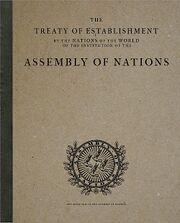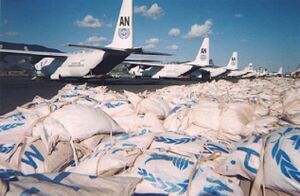Assembly of Nations
| Assembly of Nations | |||
|---|---|---|---|
| |||
| Motto: "Peace and prosperity" | |||
| Intergovernmental organization | |||
| Members | 160+ | ||
| Official languages | 100+ official | ||
| Headquarters | Unity Way∈⊾ Gobras City, Gobrassanya | ||
Governance | |||
| Legislative body | The Assembly | ||
| Formation | Establishment Treaty, 1960 | ||
| Website | www.an.int | ||
The Assembly of Nations (AN) is an intergovernmental organization made up of almost every country in the world. Its mission is to facilitate communication and to foster cooperation between governments worldwide; to promote international understanding, peace, and prosperity; and to defend the human rights and individual freedoms of people everywhere. To further these ends the AN administers a wide range of programs around the globe, including peacekeeping missions, security collaboration projects, human rights campaigns, economic and social development projects, environmental awareness and protection activities, as well as humanitarian missions for populations in crisis.
The AN headquarters and Assembly building∈⊾ is located in Gobras City, within Gobrassanya since 1966. The AN's other major offices are located in Tsanonba city∈⊾ and Hexagonia City, Tigeria∈⊾.
Current Membership
Uniquely among international organizations, every independent sovereign state is automatically considered to be a member, unless they explicitly reject membership. In addition, any entity judged by the Membership Council to "exercise stable de facto control over a territory and population" also has a right to membership, even if it is unrecognized by other AN members.
Present membership includes, but is not limited to the following countries and sovereign entities:
 Aden
Aden Airannia
Airannia Allendea
Allendea Alora
Alora Ambrosia
Ambrosia Antharia
Antharia Ardencia
Ardencia Artenia
Artenia Askanti
Askanti Azure Coast
Azure Coast Barzona
BarzonaBloenland
 Bonavista
Bonavista Bromley
Bromley Cabelia
Cabelia Canterra
Canterra Cariocas
Cariocas Castellan
Castellan Cinasia
Cinasia Demirhanlı Devleti
Demirhanlı Devleti Deodeca
Deodeca Eelanti
Eelanti Eshein
Eshein Federal States
Federal States Freedemia
Freedemia Gobrassanya
Gobrassanya Guai
Guai Helvetiania
Helvetiania Inxigne[1]
Inxigne[1] Iscu[2]
Iscu[2] Izaland
Izaland Kara
Kara Khaiwoon
Khaiwoon Kofuku
Kofuku Kojo
Kojo Kotel[3]
Kotel[3] Larcetany
Larcetany Layr
Layr Lentia
Lentia Leresso
Leresso Luslandia
Luslandia Maka
Maka Mallyore
Mallyore Mandatory Meilan[4]
Mandatory Meilan[4] Mardoumakhstan
Mardoumakhstan Mauretia
Mauretia Mazan
Mazan Mergania
Mergania Mitras
Mitras Navenna
Navenna Norrick
Norrick Novakia
Novakia Ohemia
Ohemia Ostau
Ostau Paroy
Paroy Plevia
Plevia Qennes
Qennes Sapvuodma
Sapvuodma Semanya
Semanya Suvuma
Suvuma Telkarnatha
Telkarnatha Teotiyolcan
Teotiyolcan Tigeria
Tigeria Tircambry
Tircambry Valonian Liberia
Valonian Liberia Valony
Valony Viljanni
Viljanni Vodeo
Vodeo Zalivnia
Zalivnia
History
For many decades before the founding of the Assembly of Nations, a number of treaties had established various intergovernmental authorities that focused on specific areas of function, such as the International Postal Standards Bureau, the Global Aviation Coordination Council, the Grand Commission of the Sea, and many more. As the number of these organizations began to proliferate, their jurisdictions would occasionally overlap and disputes began to arise. After a particularly heated diplomatic row, a group of influential world leaders decided to consolidate and integrate a large number of these international functions under one large umbrella organization.
The conference initially convened 1964 and began a prolonged series of negotiations. The Assembly of Nations finally came into being in 1966, with the signing of the Treaty of the Establishment of the Assembly of Nations. Fifty-six separate international organizations were placed under its jurisdiction, their functions strictly laid out so as to complement and coordinate with one another instead of clashing or conflicting. Every sovereign nation in the world, even non-signatories, was invited to participate as an equal member of the AN, and the vast majority did to varying degrees of involvement.
Symbology
The four doves found on the AN seal and emblem symbolize peace in all four directions of the compass, in all four corners of the world.
Organization
The Assembly of Nations encompasses six principal institutions: the Assembly itself (the primary deliberative body, made up of one representative ambassador from each member nation); the International Peace Council (for matters pertaining to issues of peacekeeping and security); the Social and Economic Council (for the furtherance of social and economic progress); the Chief Secretariat (the general executive of the AN); and the International Criminal Court (the paramount judicial venue). Four of the six primary institutions are located at the AN's central headquarters in Gobras City, with the fifth being the International Criminal Court, which is based in Tarott, Kalm, and the sixth being the Mandatory Estates Council, which is based in Hexagonia City, Tigeria. There are a large number of other AN-affiliated and related agencies distributed around the world.
References
- ↑ In free association with Tigeria, who manages formal diplomatic relations
- ↑ Sends a non-voting representative due to its status as an AN mandate Territory.
- ↑ In free association with Tigeria, who manages formal diplomatic relations
- ↑ AN mandate territory overseen by and in free association with Tigeria





